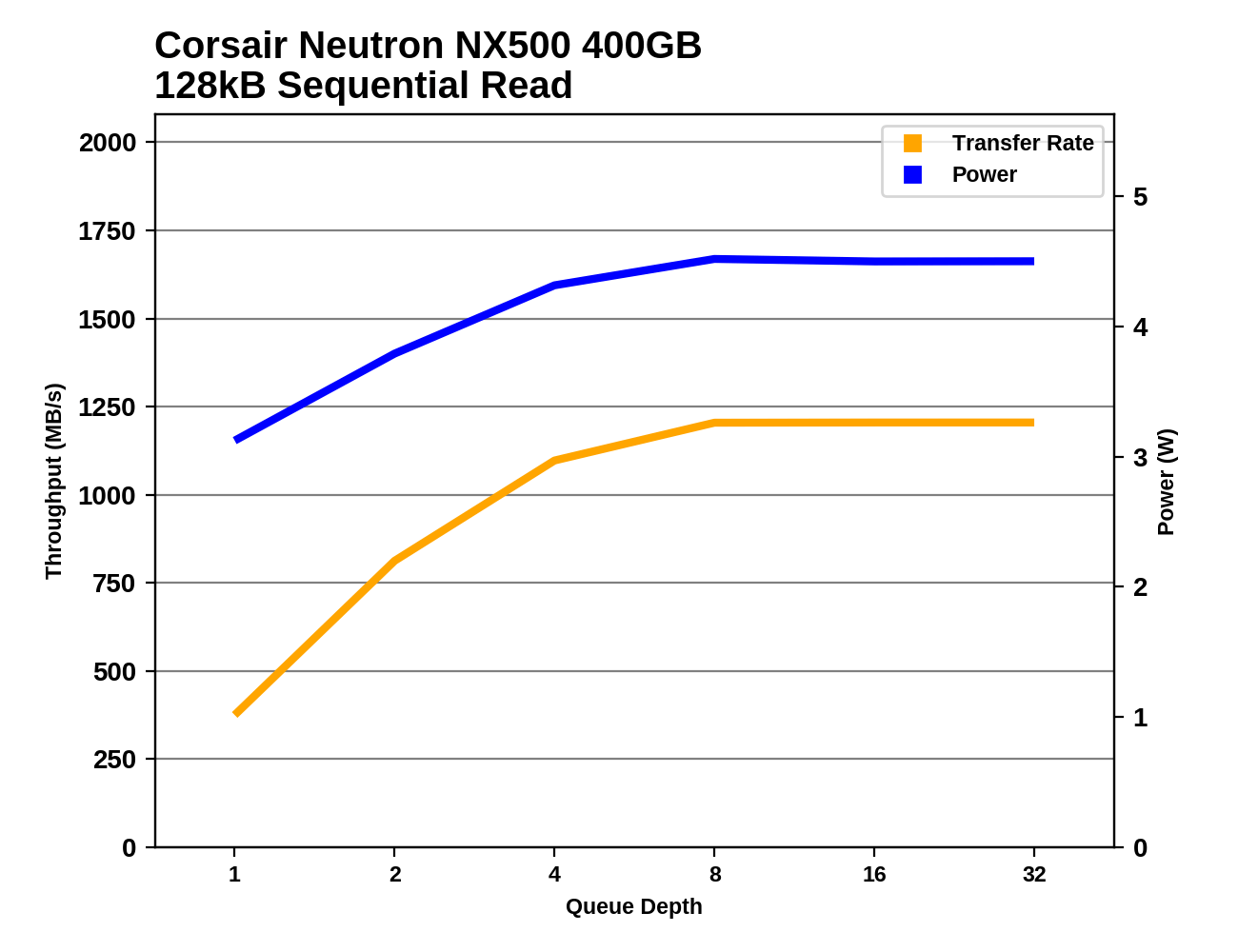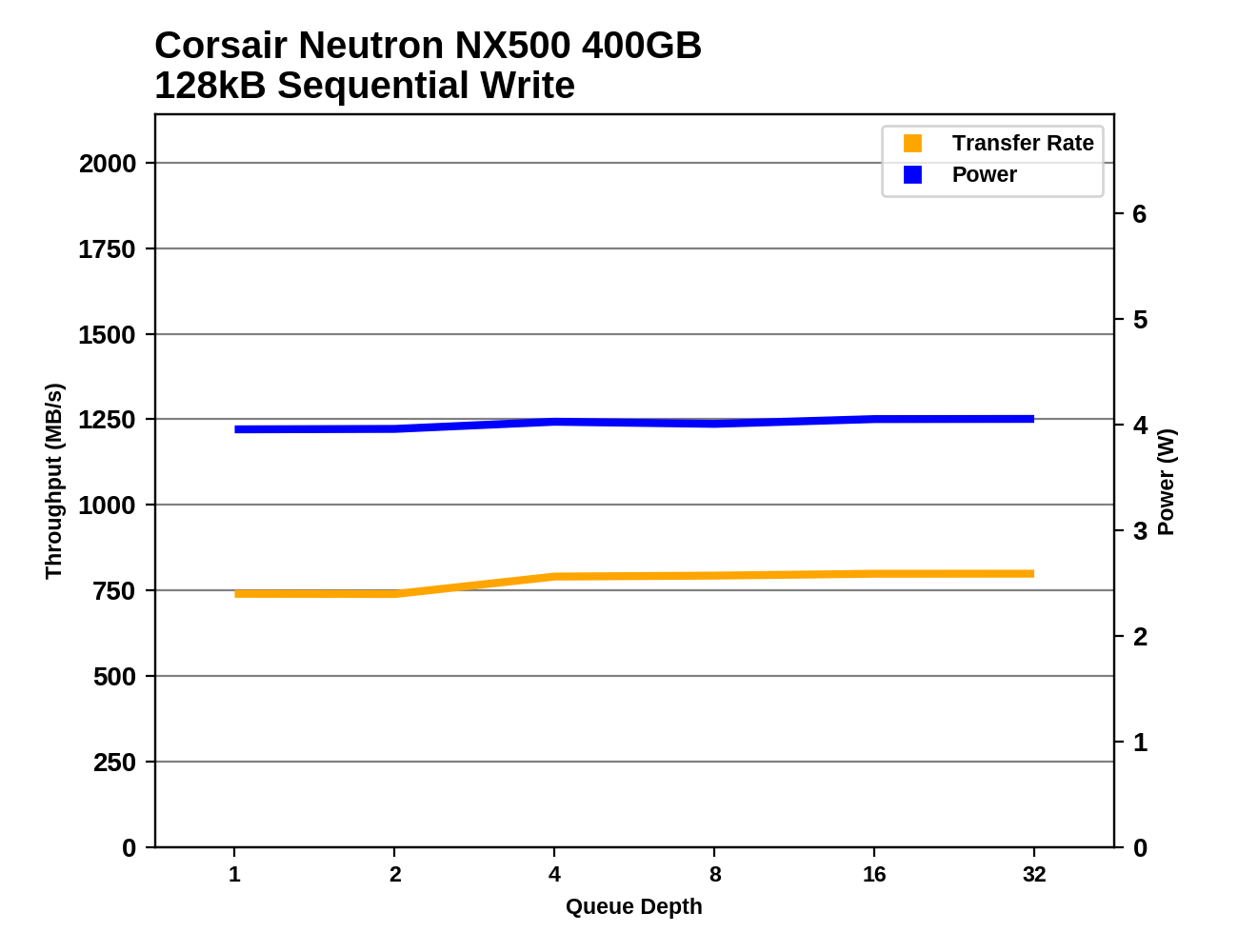The Corsair Neutron NX500 (400GB) PCIe SSD Review: Big Card, Big Pricetag
by Billy Tallis on August 16, 2017 10:00 AM ESTSequential Read Performance
Our first test of sequential read performance uses short bursts of 128MB, issued as 128kB operations with no queuing. The test averages performance across eight bursts for a total of 1GB of data transferred from a drive containing 16GB of data. Between each burst the drive is given enough idle time to keep the overall duty cycle at 20%.

The QD1 burst sequential read speed of the Corsair Neutron NX500 is a bit slower than the Patriot Hellfire, and quite a bit slower than the Plextor M8Pe. The Samsung NVMe drives are in a completely different league with QD1 read speeds more than twice as fast as any competitor.
Our test of sustained sequential reads uses queue depths from 1 to 32, with the performance and power scores computed as the average of QD1, QD2 and QD4. Each queue depth is tested for up to one minute or 32GB transferred, from a drive containing 64GB of data.

In the longer test that includes some higher queue depths, the NX500's sequential read speed is respectable and basically tied for the fastest non-Samsung drive in the bunch. It is also clearly faster than the other two Phison E7 drives.

The power efficiency of the NX500 during sequential reads is the best among the NVMe SSDs using planar NAND, and the other two Phison E7 drives follow the NX500 in the rankings. Samsung and Toshiba's 3D NAND NVMe drives offer much higher power efficiency.
 |
|||||||||
From QD1 speeds barely faster than a SATA link and half as fast as most NVMe competition, the NX500 eventually scales up to a decent saturation speed of around 1.2GB/s at QD8 or higher. Unfortunately, Samsung delivers better performance than this even at QD1, though the 960 EVO only barely so, and the 500GB version might not be quite as fast.
Sequential Write Performance
Our test of sequential write burst performance is structured identically to the sequential read burst performance test save for the direction of the data transfer. Each burst writes 128MB as 128kB operations issued at QD1, for a total of 1GB of data written to a drive containing 16GB of data.

The Corsair Neutron NX500's burst sequential write speed is the slowest of the three Phison E7 drives, but only barely and the performance is still decent for a planar NAND drive.
Our test of sustained sequential writes is structured identically to our sustained sequential read test, save for the direction of the data transfers. Queue depths range from 1 to 32 and each queue depth is tested for up to one minute or 32GB, followed by up to one minute of idle time for the drive to cool off and perform garbage collection. The test is confined to a 64GB span of the drive.

With a longer test, the Phison E7 drives hold on to their rankings though the NX500 is still the slowest of the three by a hair. Samsung's drives offer far higher sequential write speeds, but the rest of the competitors are clearly slower than the NX500.

The NX500's power efficiency during sequential writes is a bit worse than the Patriot Hellfire, but otherwise it is only beat by Samsung's NVMe drives. The next most efficient drive is the Toshiba XG5, which like Samsung's drives has the benefit of 3D NAND.
 |
|||||||||
The performance and power consumption of the Corsair Neutron NX500 during sequential writes barely changes with queue depth. The Samsung 960 EVO 1TB is more than twice as fast at QD2 or higher, so it is a very safe bet that even the 500GB version of the 960 EVO would have a significant advantage over the NX500 here.










45 Comments
View All Comments
Billy Tallis - Thursday, August 17, 2017 - link
The ATSB Heavy and Light tests include data from runs on a full drive, and The Destroyer writes more than enough data to put this drive into steady-state. Synthetic benchmarks of steady-state performance would not be more representative of real-world usage. Client drives do not get hammered with constant writes. I will eventually add some steady-state tests back into the test suite, but they will not be and never have been the most important aspect of a client drive review. They're useful to study how the drive handles garbage collection under pressure, but the impact that has on real-world performance is minimal.qlum - Friday, August 18, 2017 - link
The only place I wouldn't go for samsung is when you want to use a cheap 120gb ssd. At that point the cheapest samsung drives are just too expensive.Vorl - Wednesday, August 16, 2017 - link
did I miss something big, besides the card? This while a good review, is a very uninteresting product that just wastes space compared to a 4x m.2 slot.DanNeely - Wednesday, August 16, 2017 - link
You can put a card form factor drive in an older board without m.2 slots. Unfortunately the underlying Phision controller isn't much faster than older SATA models; making it another underwhelming product.DigitalFreak - Wednesday, August 16, 2017 - link
Even then you can buy a cheap PCI-E x4 to m.2 adapter for like $15. There's no reason for this card to exist at these capacities. If it was 2 or 4TB, maybe, but not 400/800GBmapesdhs - Thursday, August 17, 2017 - link
Yup, I have a 960 Pro 512GB on an Akasa card on an X79 board, does about 3.5GB/sec in CDM.Pity the review didn't mention the cheaper SM951/SM961, and they really need to get a 960 Pro to round out the data, the one I bought wasn't that much more than the EVO and it's a far better product. I don't like the 960 EVO, it's slower than the 950 Pro most of the time.
r3loaded - Wednesday, August 16, 2017 - link
> Skip to the graphs.> Another SSD that gets pwned by a 960 Evo, nevermind the Pro.
> Write this comment, ignore the rest of the review and close the tab.
creed3020 - Tuesday, August 22, 2017 - link
+1Unfortunately so, wish it wasn't......very disappointing Corsair.
timchen - Wednesday, August 16, 2017 - link
If I am not mistaken, 960 EVO 1 TB can perform quite differently to 500GB... so using the 1TB performance per dollar does not seem very fair to the 400 GB...Billy Tallis - Wednesday, August 16, 2017 - link
I do wish I had a sample of the 500GB 960 EVO, because performance does generally scale with capacity. But it's pretty safe to assume that at low queue depths and while the SLC cache isn't full, the 500GB 960 EVO will perform similarly enough to the 1TB that it still beats the Phison E7 drives.